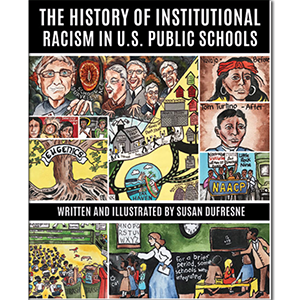
Our students are awash in a mainstream culture that tends to water down what makes them unique individuals, and the various cultural and ethnic backgrounds they bring with them. In the past, this has been an intentional policy in our schools, particularly with Black and brown students. Native Americans were shipped off to boarding schools where their hair was cut and languages eradicated. The Spanish language was likewise forbidden in many schools. (See Susan DuFresne’s illustrated book, The History of Institutional Racism in US Public Schools – cover shown above).
But a renewed movement for Ethnic Studies is actively challenging this pattern, and having a strong impact on the academic success of participating students. In a recent study, researchers from Stanford University found that students enrolled in Ethnic Studies courses in San Francisco showed real gains. Attendance improved by 21%, GPAs rose by 1.4 points, and students earned significantly more credits, making graduation more likely and college more accessible. More research on the impact of ethnic studies is available here.
More schools around the country are noticing this trend and making Ethnic Studies courses available to their students. Given the current wave of racism we are witnessing in our society, these courses are vitally important for white students as well.
The Role of PBL
Project Based Learning creates an opportunity for teachers of a broad range of grades and courses to have their students explore topics related to culture and history. This can give students a chance to discover their own heritages and those of their classmates. One of the keys to success in Project Based Learning is connecting to topics that matter to our students. Allowing students to choose a project that relates to their own identity can tap into powerful interests, as can be seen in this video of students in Santa Ana, California, sharing an art exhibit they organized.
Ethnicity has always been a challenging area for our schools. In the past, teachers have responded to racial tension by attempting to ignore race. This “colorblind” approach can make students of color feel invisible. When we open this subject, feelings can arise, and as teachers we need to do some work ourselves to prepare. If you are white, you may need to investigate and reflect on your own feelings and beliefs about race. It is helpful to do this work with colleagues of different races, so we can hear from people who have different experiences and perspectives from our own.
Some resources to help teachers wrestle with this exploration are:
• Race, Power and Policy: Dismantling Structural Racism
• Talking About Race and Racism
Here are some resources to help support student projects in this arena:
• The Zinn Education Project has numerous publications on various aspects of history
• Teaching Tolerance (offers lesson plans)
• I Am Poems
• Exploring Identity lesson
• Asian Immigration Timeline
• Seven Waves of Filipina/o Immigration
• European Immigration
• Latino/a Immigration Timeline
• History of the United Farm Workers
• Assimilation through Education: Native American Boarding Schools
• Excerpts from The School Days of an Indian Girl--by Zitkala-Sa (Dakota)
• Teaching for Black Lives, a new book from ReThinking Schools
Want to learn more about PBL? Check out our books.

